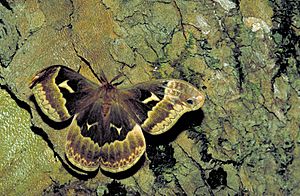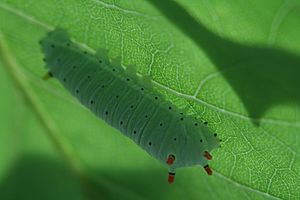Tuliptree silkmoth facts for kids
Quick facts for kids Tuliptree silkmoth |
|
|---|---|
 |
|
| Adult | |
 |
|
| Caterpillar | |
| Scientific classification | |
| Kingdom: | |
| Phylum: | |
| Class: | |
| Order: | |
| Family: | |
| Genus: |
Callosamia
|
| Species: |
C. angulifera
|
| Binomial name | |
| Callosamia angulifera (Walker, 1855)
|
|
| Synonyms | |
|
|
The tuliptree silkmoth, also known as the giant silkmoth, is a type of moth. Its scientific name is Callosamia angulifera. These moths belong to a family called Saturniidae, which includes many large and beautiful moths.
You can find the tuliptree silkmoth in many parts of North America. They live in places like Massachusetts and New York. Their home range stretches west through southern Ontario and Michigan. You can also find them as far south as the Florida Panhandle and Mississippi.
About the Tuliptree Silkmoth
Tuliptree silkmoths are quite large. Their wingspan can be between 80 and 110 millimeters. That's about the length of a standard pencil! These moths are known for their beautiful patterns and colors.
Life Cycle
The life cycle of the tuliptree silkmoth depends on where they live. In the northern parts of their range, they usually have one generation each year. The adult moths are active from June to August.
In the warmer southern areas, they can have two generations. The first group of adults flies from March to April. Then, a second group appears later in the year, around August.
What They Eat
The young tuliptree silkmoths are called larvae or caterpillars. These caterpillars love to eat the leaves of a specific tree. Their favorite food is the Liriodendron tulipifera tree, also known as the tuliptree or tulip poplar.
Once the caterpillars grow into adult moths, they do not eat at all. Their main job as adults is to find a mate and lay eggs. They get all the energy they need from the food they ate as caterpillars.

